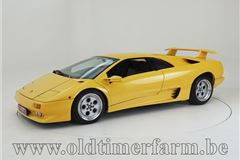Lamborghini Diablo (1990 – 1999) Review
Lamborghini Diablo (1990 – 1999) At A Glance
The Lamborghini Diablo had a tough act to follow. It was a straightforward replacement for the Countach, brought up to date, and suitably scaled up for the 1990s. The original design had been penned by Marcello Gandini (who was responsible for the Miura and Countach), but following Chrysler’s takeover in 1987 the design was changed, causing problems between the stylist and Lamborghini - and the original car becoming the Cizeta V16T.
Most significantly, though, after its launch in 1990, the Countach officially became the company’s first 200mph road car. But like the Countach QV, the Diablo still possessed an excess of grip over power. The balance was altered somewhat with the arrival of the Diablo VT in 1993. It was a four-wheel drive evolution of the Diablo - with VT standing for Viscous Traction. It was still a rear-biased car, but power could be chanelled to the front wheels when the rear ones lost their grip.
Also during '93, and to celebrate the company's 30th birthday, it launched the Diablo SE30 anniversary edition. It was presented during birthday celebrations in September 1993 in Sant Agata, surrounded by about 140 other Lamborghinis from all over the world. The SE30 developed 525bhp, compared with 492 for the original. The Diablo's power would continue to rise througout its life, culminating in 540bhp from the 1996 SV-R model.

.jpg?width=640&height=426&rmode=crop)
.jpg?width=640&height=426&rmode=crop)
.jpg?width=640&height=426&rmode=crop)
.jpg?width=640&height=426&rmode=crop)
.jpg?width=640&height=426&rmode=crop)
.jpg?width=640&height=426&rmode=crop)
.jpg?width=640&height=426&rmode=crop)
.jpg?width=640&height=426&rmode=crop)
.jpg?width=640&height=426&rmode=crop)
.jpg?width=640&height=426&rmode=crop)


 Towering performance, howling V12, all-weather security (relatively speaking) of its all-wheel drive system
Towering performance, howling V12, all-weather security (relatively speaking) of its all-wheel drive system
 Design lacks the drama of the predecessor Countach or replacement Murcielago despite gaining extra scoops and spoilers along the way
Design lacks the drama of the predecessor Countach or replacement Murcielago despite gaining extra scoops and spoilers along the way
